

What Are the Key Elements of Powerful Content
Fifty-six percent of the IT decision makers surveyed for this report have previously switched technology suppliers, at least partly, due to content they consumed. This is why this report, and your content marketing strategy, is so important.
The right content, promoted through the right channels, to the right people, is hugely influential.
It can be incredibly hard to convince technology decision makers to switch vendors or partners. There’s an intrenched incumbency bias and an aversion to the perceived hazards of switching. The case to move must be compelling. The risk of ‘sticking’ greater than the risk of ‘twisting’. Therefore, the above finding is even more meaningful. Content is still king when it comes to building brands, establishing trust, and laying out the business case for switching suppliers.
It's more nuanced than that, though. Not all content is created equal. Seventy-four percent of respondents agree with the statement, “I consider content produced by a known third party, rather than vendors themselves, more trustworthy”. It’s not just what is said, it’s who’s saying it.
Technology buyers have a natural scepticism towards vendor and partner produced content. Regardless of the rationale behind the messaging, there are always doubts around the motivation behind the content and the veracity of its conclusions. Partnering with independent, respected media partners is essential to creating and promoting the right messaging. It lends an editorial cache and reach that can’t be manufactured in-house.
This objectivity is reinforced by The Channel Company’s dedicated research findings. Eighty-four percent of those surveyed, “consider content underpinned by research to have more authority”.
Content that has a backbone of end-user or channel decision-maker survey findings running through it tends to have far more authority than an opinion piece, or even an anecdotal case study.
Over half of respondents said they consume six or more pieces of content on average when making a buying or strategy decision. Therefore, it is essential to have a strategic content program that addresses needs at all parts of the technology buying process.
When respondents were asked which technology areas have the largest information need when making buying decisions, the most common answer was cyber security, followed by cloud computing. However, technology audiences are hungry for information across all subjects and their accompanying business considerations.
There’s always an opportunity for a vendor or partner to meet that need, claim mindshare and stake their claim as a thought leader in that space.
Content marketing has always been a key weapon in the marketing manager’s armoury. It makes the case for a technology product or service – highlighting the pain point it addresses or opportunity it creates. There is huge value in being able to meet the perennial information needs of enterprise tech buyers and being perceived as thought leaders in your market. It is the best way to build trust with prospective customers – and trust is crucial when it comes to high-cost, high-risk tech purchases.
However, content marketing has changed. Strategic use of data now means we can be more intelligent about what content we are producing and how it is targeted at channel and end user audiences.
The best approaches to content marketing marry a robust understanding of market needs and preferences, and premium design and distribution with modern data-informed targeting and insights. This ensures the best possible ROI by reaching the right people, with the right content, at the right time.
This can be achieved through a capable Account-Based Marketing (ABM) solution, underpinned by a modern audience and data platform and fueled by a highly engaged first party audience. This unlocks new ways to capture, measure, and nurture engagement.
This report reveals how to transition your brand building and demand generation strategies from hunting to farming, from random acts of marketing to an always-on, strategic, measured, targeted, full-funnel, intent-based approach – with content at its heart.
About Our Research
This report, featuring our dedicated research findings, uncovers the value of content marketing for enterprise technology decision makers today.
We surveyed over 100 end user enterprise technology decision makers from a wide range of industries and company sizes. Job roles ranged from c-level and corporate management to IT team leader and technical roles. All respondents consume technology content as part of their remit.
Whether you’re an end user or channel marketer, it’s essential you understand the importance of content and the most effective strategies for success.
Why Content is King
Your products and people make your business but only your brand can make it great. No one buys a cyber security solution from a company they’ve never heard of before, no matter how appealing their feature set and pricing is.
Fifty-six percent of our research respondents for this report have previously switched technology suppliers, at least partly, based on content they consumed. A further 23% are unsure, though they have likely been influenced by content too.
Proportion of organisations that have switched suppliers or partners at least partly based on content consumed in the past.
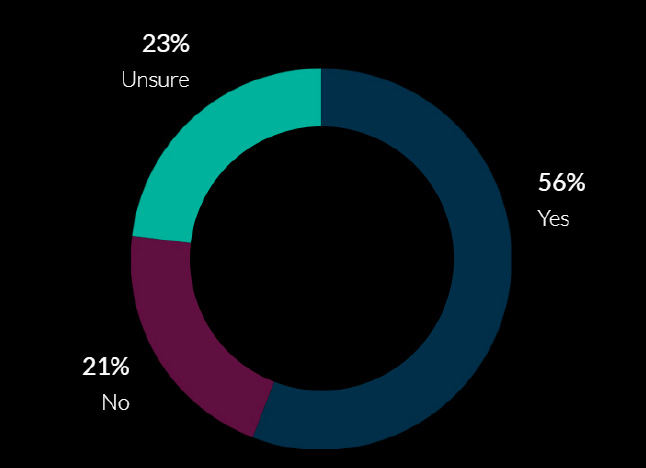
The sentiment behind the old cliché, “no one has ever been fired for buying IBM” still holds true today.
The CIO makes technology purchasing decisions based on not only what is best for their company but also on what is best for their career. Those two things often aren’t completely aligned. They can even be completely opposed. It is what makes us go for what we perceive to be the safer buying option. The brands we know best may not be most cost effective, or even the outright best performing, but we’re confident they will at least deliver a satisfactory solution that won’t threaten business continuity, reputation, or finances.
No one buys a cyber security solution from a company they’ve never heard of before, no matter how appealing their feature set and pricing is.”
As Daniel Kahneman relays in Thinking, Fast and Slow, “The psychologist, Paul Rozin, an expert on disgust, observed that a single cockroach will completely wreck the appeal of a bowl of cherries, but a cherry will do nothing at all for a bowl of cockroaches.” This is one of the reasons you pay more for a well-known brand. Their reputation not only implies they’re capable, but it also means they have more to lose by damaging that reputation. We perceive them to have more skin in the game.
The German psychologist Gerd Gigerenzer refers to this as Defensive Decision-Making. It may not appear to be the most objective or rational approach to assessing your options, but it is understandable, and thought to be an evolutionary instinct. This is the default approach to technology buying behavior and marketing content needs to adapt accordingly – particularly if you’re a challenger going up against the incumbents.
How content informed technology buyer decisions to switch.
“We were not happy with a current supplier and were impressed by what we learnt from content read on a new supplier”
“Once contracts were due, we re-evaluated our requirement and vendor”
“A white paper showed a high level of understanding of the subject matter by a new reseller and prompted inclusion in the selection process”
“Content raised my awareness of competitor options”
“Content gave reassurance that our new supplier was a good fit for our needs”
“I used content to support my understanding of the benefits of switching”
Let’s pick out a few key words and phrases from these responses: ‘impressed’, ‘awareness’, reassurance’, ‘understanding’. These are emotive words. Technology buyers can easily research product features and SLAs on vendor websites. What they often don’t get from that is the sense that their needs are understood, or an impression of thought leadership – reassured that they’re in safe hands. Even in technical B2B sectors, buyers make emotional decisions first and post-rationalize them afterwards – though they may not be aware of this fact. Or, in Jonathan Haidt’s words, “The emotional tail wags the rational dog.”
Across all of this you need to connect with your audience on an emotional level. Marketing to the individual first and the job title second. Research conducted by Kantar, in partnership with the University of Oxford, identified the following core values in marketing activity that grows your brand equity:
Meaningful: relevantly meeting functional and emotional needs in a category
Different: a combination of being seen as unique and leading the way
Salient: coming to mind easily when making a choice between brands
Top 5 most useful content types when making a buying or strategy decision
Case studies rank top of the five most useful content types displayed above. These are essentially stories – lessons learned from those who have been there and done it already. Decision makers use them to avoid mistakes made by others or reassure themselves that they are taking the right path.
The same is true of anecdotes from colleagues and peers. Stories about integrations or migrations gone wrong are hugely influential. They are not scientific or even rational reasons for excluding vendors or partners from consideration, but they will undoubtedly color your own decision-making process.
There is something innately human about storytelling. From our origins as hunter-gatherers, huddled around a fire or painting a cave wall, stories and the meanings they convey have been an essential part of the human experience.
Storytelling captivates us in a way other marketing activity cannot.
Numerous studies have demonstrated the power of emotion and creativity in boosting brand awareness, often doubling the memorability over more ‘rational’ approaches.
Influence of enterprise technology content when making buying and strategy decisions.
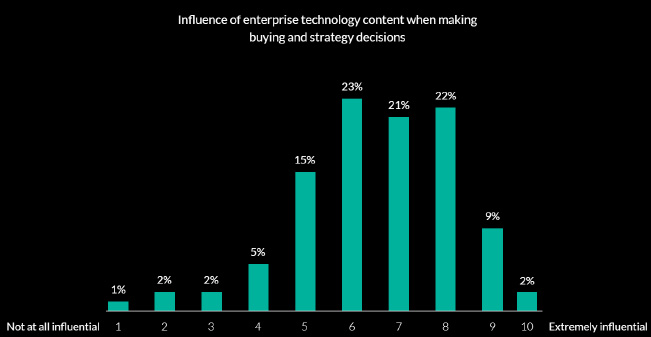
One-in-three respondents rated the influence of content at an eight or higher. Just one-in-ten rated it lower than five. Content should be at the heart of your marketing efforts if you’re trying to influence buyers, regardless of whether it’s at the conscious or subconscious level.
What is it about the cyber security and cloud markets that mean they have the greatest information need in the tech sector? These are technology areas that affect every business. They are high risk – a failed cloud migration or security breach could mean loss of business continuity, and financial and reputational fallout. They are also complex undertakings in a fast-moving industry, meaning buyers must keep up to date on market trends and developments.
“The best content hangs its premise on a pain point faced by its target audience. It addresses what keeps them up at night.”
What Makes a Thought Leader?
A trusted thought leader is someone who understands and communicates your needs and challenges, and helps guide you in overcoming them. They are allies against the enemy in common. When thought leadership is distributed as a vendor or channel partner, it becomes an essential part of the brand identity tied to your products or services.
Your brand can become more than a commercial proposition, something customers can feel affiliation with and loyalty towards.
Great thought-leadership content is, as we’ve demonstrated, extremely influential – but it needs to be. Research previously conducted by The Channel Company shows a widespread incumbency bias amongst decision makers. The solution they use is the one they perceive to be the ‘best-in-market’ – not the other way around.
Given the business continuity risks touched on previously, there needs to be a compelling and emotive argument for changing suppliers. The desire to not make bad decisions is stronger than the desire to make good ones. A failed cloud migration is far more likely to incur serious career implications for a CIO than sticking with their existing on-premises solution that, in the eyes of the CEO, does the job just fine.
To what extent do you agree with the statement, “I consider content produced by a known third party, rather than vendors themselves, more trustworthy”?

Seventy-four percent of end-user decision makers believe third-party content to be more trustworthy than that produced by vendors. Just 8% disagreed. And, as we’ve established, trust is absolutely crucial to effective marketing.
This is where independent third-party publishers can lend their editorial cache, audience relationships, and market understanding. The average technology decision maker is naturally cynical when it comes to content produced by vendors and partners themselves. This is regardless of its quality or whether there is research involved.
“A trusted thought leader is someone who understands and communicates your needs and challenges, and helps guide you in overcoming them. They are allies against the enemy in common.”
Becoming the Authority
To what extent do you agree with the statement, “I consider content underpinned by research to have more authority”?

The need for objectivity is reinforced by the desire for bespoke research findings. Eighty-four percent of those surveyed, “consider content underpinned by research to have more authority”. Just 3% disagree.
While others are leaning on unfounded marketing claims, assumptions, and vague promises, independent research can lay-out an objective case for your proposition. Aligning your brand with the needs identified by said research, and the suitability of your offered solutions. This lends your content more weight and objectivity, while still hanging the content on the emotive pain points that trigger engagement with it in the first place.
For example, a research report with a sponsor looking to promote the value of automated cyber security threat detection and remediation might be structured as follows:
It’s a template that dates back to the reasoning of the ancient Greek philosophers. It has stood the test of time. If you accept the premises, in turn, logic dictates you must agree with the conclusion.
Independent research, when carried out in alignment with a client’s marketing goals, provides objective findings that do the selling for them. The case for their product or services is clearly laid out in unequivocal data visualisations, graphs, and infographics. It does this while meeting the information needs of its audience.
Good content marketing is always a value exchange.
Content Quality and Quantity
These findings are backed up by the text responses from those surveyed when asked to share ways technology content could be improved.
End user thoughts on ways to improve content
“More customer-based, less marketing spin, more independent information”
“More independently verified and not based on vendor sales campaigns or partnership deals”
“Trustworthy independent sources”
“Easier to find unbiased opinion”
“Better targeting”
“Needs to be unbiased, and balanced, clear about drawbacks as well as benefits, and honest about risks”
“Better research”
Research by marketing strategy heavyweights Les Binet and Peter Field shows that, when it comes to brand equity and share of voice, it’s much easier (and cheaper) to maintain a dominant brand position than it is to challenge it. The challenger brands must spend more or be more effective to gain market share. Market leaders typically get three times the return on their investment in comparison. However, creative is a brand amplifier.
Great content can be an extremely powerful differentiator.
When the IT or channel leaders you’re marketing to are time poor, with myriad demands on their attention, it’s vital you ‘meet them where they are’ by distributing content across social, email, editorial and events channels, with themes and headlines that grab their attention. It’s not enough just to have content ‘collateral’. Content is not a commodity. It needs to be in the top few percent in terms of quality and it needs to reach the right audience if you are to differentiate your brand, gain mindshare and, ultimately, market share.
“Good content marketing is always a value exchange.”
One way to do this is by leaning on great design and interactive elements to captivate readers. Interactive content drives more engagement from audiences and keeps people reading for longer. Using animation, interactive tools or infographics, and embedded audio and video are all great ways to achieve this and provide additional value to your target audience.
Regardless of the medium, your headlines need to hook your reader in an instant. The best content hangs its premise on a pain point faced by its target audience. It addresses what keeps them up at night. Or it does the opposite and highlights a great opportunity (as espoused by Ogilvy Vice-Chairman Rory Sutherland, sometimes the opposite of a good idea is also a good idea).
Good content identifies this kind of pain point or opportunity and builds an attention-grabbing theme and angle around it.
Average number of content pieces consumed when making a buying or strategy decision
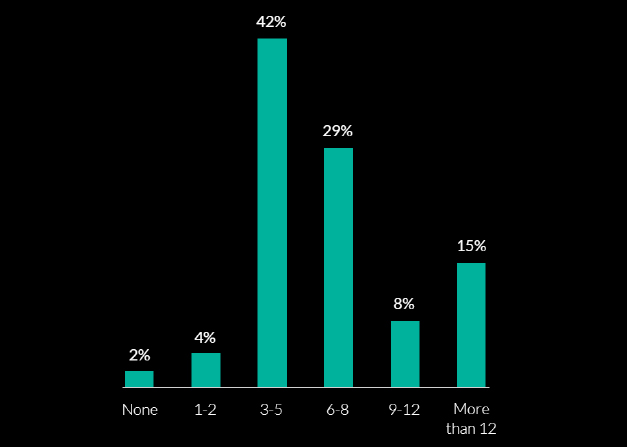
While quality is important. You also need to have sufficient quantity – typically, this means core hero assets on top-level themes, combined with a long tail of more granular topics – each targeted at various parts of the buying journey. With so many different roles involved in the decision-making process, at different parts of the journey, marketeers need to be meeting these information needs and influencing every step of the way.
“A flower is simply a weed with an advertising budget.”
- Rory Sutherland, Alchemy
Roles involved in the technology buying process
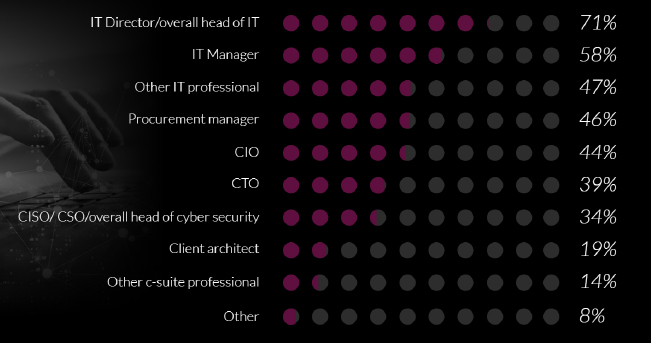
Number of people involved in the buying process
When asked how many people were involved in the technology buying process, these were just some of the responses:
Way too many!
Normally around 5-10
Approximately 30 to 40 people
Approximately 10-15
Around 12
It varies depending on domain/size but normally between 5 and 30
Many, across disparate parts of the organisation
Several different departments at different levels, depending on impact and benefits
This proliferation of stakeholders represents what, in the enterprise technology world, is often an 18-month buying cycle. A strategic marketing strategy will engage these roles at the top, middle and bottom of funnel, first building brand awareness and mindshare, before nurturing trust, disseminating thought leadership, and fostering a sense of loyalty. The very best will do this with an always-on, evergreen approach to its most valuable content.
On top of the volume of content and variety of roles, which in themselves create a need for diverse content types and topics, our respondents also expressed a need for content throughout the decision-making process. When assessing their technology needs, identifying suppliers, researching their capabilities, selecting a shortlist of vendors, and then reviewing them, there is a crucial role for content and, therefore, an opportunity to influence and build trust.
Looking at the number of content pieces consumed, the variety of roles involved, and the range of buying stages, you’re looking at a complex targeting and analytics picture. What’s the best way to make sense of this? We explore this next.
Top 5 buying process stages in which relevant content is consumed
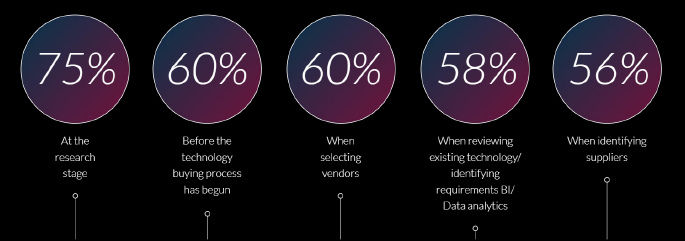
Account Based Marketing: Where Efficiency Meets Effectiveness
Having the very best first party data, targeting, analytics and nurturing capabilities, without great content, will see your marketing strategy falling short. It’s a skeleton without its organs. The inverse is also true. What use is content without an audience and data ‘skeleton’ to mobilize it? Great content without intelligent distribution and insights off the back of it is an inefficient way to get your message heard.
Content marketing should be both data-informed and data-generating. Account based marketing (ABM), underpinned by a capable audience and data platform and fueled by high-quality first party data, can ensure you are targeting and catering for your most engaged accounts, unlocking the true value of your content.
By linking together intent signals across an entire audience, including content, events, email, and social, you can measure and rank real intent across an entire audience ecosystem.
From top of funnel brand building activity, all the way down to bottom of funnel customer activation and face-to-face engagement, if you can tell what the most engaged accounts are, what their needs are, and how best to influence them, you have won half the battle when it comes to growing your brand and your business.
This allows your marketing and sales function to efficiently target the 5% of your target audience who are in-market, while your content marketing and brand building activity is effectively nurturing the remainder. Such an approach allows you transition from aimless demand ‘hunting’ to ‘farming’.
“It’s not enough just to have content ‘collateral’. Content is not a commodity.”
Without long-term goals, marketing initiatives are short-term tactics rather than true strategies.
Some technology marketing strategies fail to look beyond the end of the quarter, even when board members are planning across the next five years. It’s difficult to solve this short-termism. It requires CMO’s to be able to effectively communicate the value of longer-term brand marketing to their CFOs (who often need to prioritize that quarter’s targets). This report is helping to equip marketing leaders to do just that.
Many tech B2B marketing strategies focus far too much on bottom of funnel activation activity (capturing the 5%), and not enough on the long-term brand awareness and nurturing activity that means you’re being considered in the first place. The long- and short-term approaches need to be working in tandem. A 55:45 budget split between longer-term brand building and short-term activation is a good rule of thumb in the enterprise tech market, though there are exceptions.
Particularly in a downturn, there is a tendency to ‘go short’ and prioritize activation-based marketing activity. This is because it is more measurable and it is easier to demonstrate ROI to your business leaders. It drives immediate returns. However, perceived efficiency is not the same as effectiveness – particularly if you do this for more than one quarter. Bigger brands are more resilient in this situation, but you’ll soon find your brand presence falling in your target market, and your pipeline drying up.
It's helpful to imagine content marketing like a garden that you should harvest while also planting seeds for tomorrow. Building and tending a long-term content strategy requires attention, consistency, and patience. Though you’ll have to wait for some results after seeding your content program, the output is worthwhile: Greater mindshare, thought leadership, and supportive content across the full buyer’s journey — and increased trust among IT decision makers that your brand is an investment worth making.
The expert content strategists, copywriters, and designers of The Channel Company Agency can help you craft a content strategy that differentiates your brand and delivers measurable returns on your investment. Contact us today.